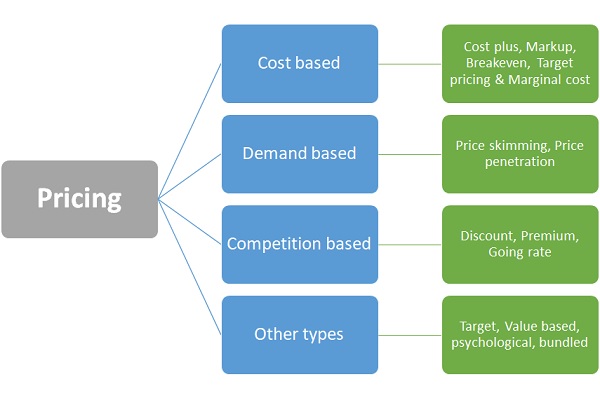- Business Concepts ›
- Marketing and Strategy ›
- Pricing Strategy
Pricing Strategy
Definition, Importance, Types, Factors & Example
This article covers meaning & overview of Pricing Strategy from marketing perspective.
What is meant by Pricing Strategy?
Pricing strategy in business is the amount of money a company must charge a buyer. Pricing is the monetary value which a customer pays to fulfill a need for using a product of service. Pricing strategy is an activity which determines what should be the payable amount for a product depending upon factors like demand, cost, competition, market etc.
Importance of Pricing Strategy
Pricing is one of the toughest challenges encountered by the firms as the prices should not only be relevant as per the current market scenario, but should also meet the expenses of the firm and help it gain profit. It must also take into account competitor’s pricing. Hence, it is important to choose the right pricing strategy.
The right pricing strategy makes sure that the product or service is available to the customer at the price point which is right as per the need and also makes profit for the company. There is no fixed approach when it comes to pricing. It has to be reviewed and continuously updated as per the market as well as competitive landscape.
Product Pricing Factors
Some of the main factors which help determine the price of a product or service are:
1. Understand production costs: the price of the goods should be higher than production costs to ensure profit margins.
2. Evaluate price & profits: pricing strategy should consider other overhead costs like marketing, support etc. & evaluate margins.
3. Identify customers- the customer segment being target also decides the price, whether it’s a low-cost mass product or high value niche product.
4. Product positioning- a similar product type can be positioned differently & hence the pricing strategy is calculated.
5. Value of goods: the perceived value of goods based on demand also defined the product price.
6. Competition pricing: a major factor in determining the value of goods are at what prices are competitors offering similar goods.

Types and Examples of Different Pricing Strategies
Pricing methods are the methods that firms use to calculate the price of their products. The various methods are as follows:
1. Cost based pricing
After calculating the total production costs, a target profit margin is levied on it.
Example – If the production cost of a pen is $100 and the target profit margin is 10%, then the price of pen would be 100 + 10% of 100 = $110.
Some of the other cost-based methods are cost plus, markup, break even, target & marginal cost strategy.
2. Demand based pricing
This strategy is used when their price is determined by customer demand.
Example- price of hotels & hospitality increases during the festive season owing to high demand.
Some of the demand-based strategies are price skimming & price penetration.
3. Competition based pricing
The prices in this type of method are decided by what the competition is offering. The different types of pricing strategies include discount, premium & going rate methods.
4. Target Pricing
Total investments are determined and a target rate of return is applied to it to attain the desired return on investment.
Example – If the investments in the production of cups are $100 and the target rate of return is 5%, then the price of the cups will be 100 + 5% of 100 = $105.
5. Value based pricing
The price is calculated based on the value being provided to the customers.
Example – If a personal coaching for 10 days in a particular subject is equivalent to attending a coaching class consisting of 20 students for 20 days, then the person would be willing to even pay the fee that he pays for the coaching classes for his personal tuitions. This is assuming that the coaching class charges higher fee than the personal coaching.
6. Psychological pricing
This is based on the psychological impact that the price would produce on the customers.
Example – These days we see a lot of products are priced at an amount less than some round figure (say $199 instead of $200). This is so because the customers respond positively to such prices.
Some other pricing strategies which be used as per the requirement, factors, market conditions, margins etc. are bundled, prestige & affordable pricing.
Hence, this concludes the definition of Pricing Strategy along with its overview.
This article has been researched & authored by the Business Concepts Team which comprises of MBA students, management professionals, and industry experts. It has been reviewed & published by the MBA Skool Team. The content on MBA Skool has been created for educational & academic purpose only.
Browse the definition and meaning of more similar terms. The Management Dictionary covers over 1800 business concepts from 5 categories.
Continue Reading:
What is MBA Skool?About Us
MBA Skool is a Knowledge Resource for Management Students, Aspirants & Professionals.
Business Courses
Quizzes & Skills
Quizzes test your expertise in business and Skill tests evaluate your management traits
Related Content
All Business Sections
Write for Us